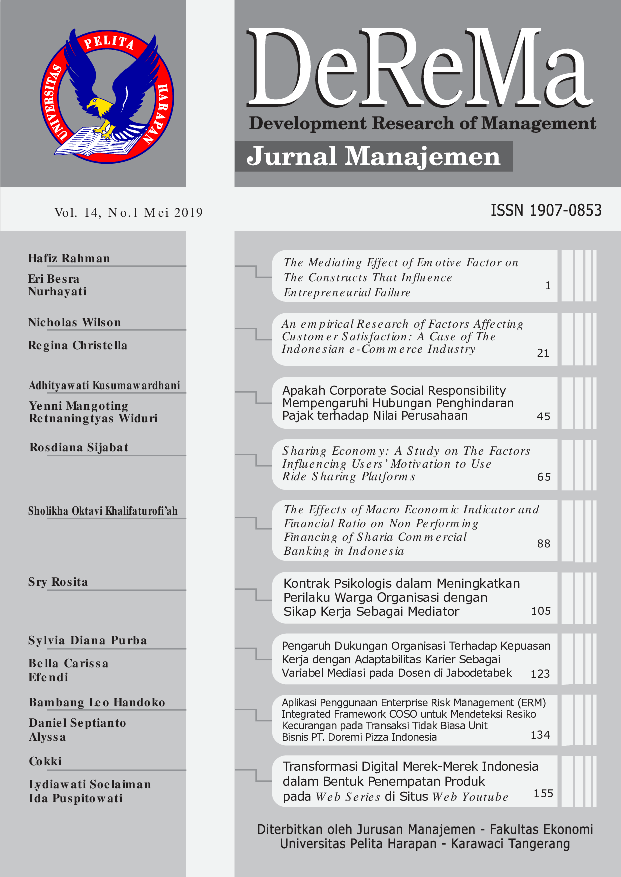Sharing Economy: A Study on the Factors Influencing Users' Motivation to Use Ride Sharing Platforms
##semicolon##
https://doi.org/10.19166/derema.v14i1.1367##semicolon##
sharing economy##common.commaListSeparator## ride sharing초록
This research is intended to explore sharing economy, particularly ride sharing. The study aims to identify the impact of four factors””economic, social, environmental, and technological””on individuals' motivation and decision to use three ride sharing platforms: UBER, GRAB and Go-JEK in Indonesia. Based on available literature, four research hypotheses are tested, namely that (1) economic factors; (2) social factors;(3) environmental factors; and (4) technological factors have positive influence on individuals' motivation and decision to use ride sharing services. Primary and secondary data are used to answer the research questions. Primary data were obtained through an online survey of 355 respondents, while secondary data were obtained from various related literatures. The research is both descriptive and quantitative in nature, the empirical analysis suggest that economic, social, environmental, and technological factors are positively associated with users' decision to use ride sharing.
Bahasa Indonesia Abstrak: Penelitian ini bertujuan untuk mengeksplorasi konsep sharing economy, khususnya ride sharing. Secara khusus, studi ini bertujuan untuk mengidentifikasi pengaruh dari empat factor, yaitu faktor ekonomi, sosial, lingkungan, dan teknologi terhadap motivasi dan keputusan individu untuk menggunakan tiga platform perjalanan bersama: UBER, GRAB, dan Go-JEK di Indonesia. Berdasarkan literatur yang tersedia, empat hipotesis penelitian diuji, yaitu bahwa (1) faktor ekonomi; (2) faktor sosial; (3) faktor lingkungan; dan (4) faktor teknologi memiliki pengaruh positif terhadap motivasi dan keputusan individu untuk menggunakan layanan ride sharing. Data primer dan sekunder digunakan untuk menjawab pertanyaan penelitian. Data primer diperoleh melalui survei online terhadap 355 responden, sedangkan data sekunder diperoleh dari berbagai literatur terkait. Penelitian ini bersifat deskriptif dan kuantitatif, analisis empiris menunjukkan bahwa faktor ekonomi, sosial, lingkungan, dan teknologi secara positif terkait dengan keputusan pengguna untuk menggunakan berbagi perjalanan.
##submission.citations##
Alphabeta. (2017). Rethinking Urban Mobility in Indonesia: The Role of Shared Mobility Services. [Online] Available at: http://www.alphabeta.com/wp-ontent/uploads/2017/05/FA-UberReport-Indonesia _English.pdf [Accessed 1 September 2017].
Bardhi, F. & Eckhardt, G. ( 2012). Access-based consumption: The case of car sharing. Journal of Consumer Research, 39(4), 881-898. https://doi.org/10.1086%2F666376
Bartlett, A. A. (2016). Reflections on Sustainability, Population Growth, and the Environment. [Online] Available at: http://www.npg.org/wp-content/uploads/2016/01/2016-ReflectionsOnSustainabilit yForumPaperrev.pdf. [Accessed 6 June 2017].
Belk, R. (2014). You Are What You Can Access: Sharing and Collaborative Consumption Online. Journal of Business Research, 67(8), 1595-1600. https://doi.org/10.1016%2Fj.jbusres.2013.10.001
Blaikie, N. (2010). Designing Social Research: The Logic of Anticipation (2nd ed). Cambridge: Polity Press.
Böcker, L. & Meelen, T. (2016). Sharing for People, Planet or Profit? Analysing Motivations for Intended Sharing Economy Participation. Environmental Innovation and Societal Transitions, 23, 28-39. https://doi.org/10.1016%2Fj.eist.2016.09.004
Botsman, R. (2015). Defining The Sharing Economy: What Is Collaborative Consumption””And What Isn't? [Online] Available at: https://www.fastcoexist.com/3046119/defining-the-sharing-economy-what-is-coll aborative-consumption-and-what-isnt. [Accessed 28 January 2017].
Botsman, R. & Rogers, R. (2010). What’s Mine Is Yours: The Rise of the Collaborative Consumption. New York (NY): Harper Business.
Casey, G. & Galor, O. (2017). Is Faster Economic Growth Compatible with Reductions in Carbon Emissions? The Role of Diminished Population Growth. Environmental Research Letters, 12(1), 014003. https://doi.org/10.1088%2F1748-9326%2F12%2F1%2F014003
Chan, N. & Shaheen, S. (2012). Ridesharing in North America: Past, Present, and Future. Transport Reviews, 32(1), 93-112. https://doi.org/10.1080%2F01441647.2011.621557
Cherry, K. (2017). Motivation: Psychological Factors That Guide Behavior. [Online] Available at: https://www.verywell.com/what-is-motivation-2795378 [Accessed 23 November 2017].
Cohen, B. & Kietzmann, J. (2014). Ride On! Mobility Business Models for the Sharing Economy. Organization & Environment, 27(3), 279-296. https://doi.org/10.1177%2F1086026614546199
Collaborative Economy Spreadsheets. (2016). [Online] Available at: https://docs.google.com/spreadsheets/d/12xTPJNvdOZVzERueyA-dILGTtL_KW KTbmj6RyOg9XXs/edit#gid=253059398 [Accessed 19 November 2017].
Deloitte. (2015). Review of the Collaborative Economy in NSW. [Online] Available at: https://www2.deloitte.com/au/en/pages/economics/articles/review-collaborative-e conomy-nsw.html. [Accessed 25 November 2017].
Figueroa, M. (2016). Sharing + Technology = Experience. [Online] Available at: https://www.ila.org/publications/ila-reporter/article/23/sharing-technology-experi ence [Accessed 10 August 2017].
Frenken, K. & Schor, J. (2017). Putting the Sharing Economy into Perspective.Environmental Innovation and Societal Transitions, 23, 3-10. https://doi.org/10.1016%2Fj.eist.2017.01.003
Furuhata, M., Dessouky, M., Ordóñez, F. & Brunet, M.-E. (2013). Ridesharing: The State-of-the-art and Future Directions. Transportation Research Part B: Methodological, 57, 28-46. https://doi.org/10.1016%2Fj.trb.2013.08.012
Godelnik, R. (2017). Millennials and the Sharing economy: Lessons from a ”˜Buy Nothing New, Share Everything Month’ Project. Environmental Innovation and Societal Transitions, 23, 40-52. https://doi.org/10.1016%2Fj.eist.2017.02.002
Goudin, P. (2016). The Cost of Non-Europe in the Sharing Economy: Economic, Social and Legal Challenges and Opportunities. [Online] Available at: https://epthinktank.eu/tag/cost-of-non-europe/ [Accessed July 2017].
Gredler, M., Broussard, S. & Garrison, M. (2004). The Relationship between Classroom Motivation and Academic Achievement in Elementary School Aged Children. Family and Consumer Sciences Research Journal, 33(2), 106-120. https://doi.org/10.1177%2F1077727x04269573
GrybaitÄ—, V. & StankeviÄienÄ—, J. (2016). Motives for Participation in the Sharing Economy - Evidence from Lithuania. Economia i Zarzadzanie, 8(4), 7-17. https://doi.org/10.1515%2Femj-2016-0028
Hahn, R. & Metcalfe, R. (2017). The Ridesharing Revolution: Economic Survey and Synthesis. [Online] Available at: https://www.brookings.edu/wp-ontent/uploads/2017/01/ridesharing-oup-1117-v6-brookings1.pdf. [Accessed 14 November 2017].
Hamari, J., Sjöklint, M. & Ukkonen, A. (2015). The Sharing Economy: Why People Participate in Collaborative Consumption. Journal of the Association for Information Science and Technology, 67(9), 2047-2059. https://doi.org/10.1002%2Fasi.23552
Heinrichs, H. (2013). Sharing Economy: A Potential New Pathway to Sustainability. Gaia-Ecological Perspectives for Science and Society, 22(4), 228-231. https://doi.org/10.14512%2Fgaia.22.4.5
Kuhnimhof, T., Chlond, B., von der Ruhren, S. (2006). Users of transport modes and multimodal travel behavior. Transportation Research Records : Journal of the Transportation Research Board, 1985, 40-48. https://doi.org/10.3141/1985-05
Leismann, K., Schmitt, M., Rohn, H. & Baedeker, C. (2013). Collaborative Consumption: Towards a Resource-Saving Consumption Culture. Resources, 2(3), 184-203. https://doi.org/10.3390%2Fresources2030184
Lundberg, C., Gudmundson, A. & Andersson, T. D. (2009). Herzberg’s Two-Factor Theory of Work Motivation Tested Empirically. Tourism Management, 30, 890-899. https://doi.org/10.1016/j.tourman.2008.12.003
Manerikar, V. & Manerikar, S. (2014). A Note on Exploratory Research. aWEshkar, XVII(1), pp. 95-96.
Martin, C. J. (2016). The Sharing Economy: A Pathway to Sustainability or a Nightmarish Form of Neoliberal Capitalism?. Ecological Economics, 121, 49-159. https://doi.org/10.1016%2Fj.ecolecon.2015.11.027
Matofska, B. (2016). What is the Sharing Economy? Retrieved September 14, 2017, from http://www.thepeoplewhoshare.com/blog/what-is-the-sharing-economy/.[Accesse d 7 September 2017].
Matzler, K., Veider, V. & Kathan, W., 2015. Adapting to the Sharing Economy. [Online] Available at http://sloanreview.mit.edu/article/adapting-to-the-sharing-economy/ [Accessed 28 October 2017].
McBeth, J., 2017. No Fast Track in Indonesia. [Online] Available at: http://www.atimes.com/article/no-fast-tracks-indonesia/ [Accessed 20 November 2017].
Merriman, M. (2015). What If the Next Big Disruptor Isn’t a What but a Who? [Online] http://www.ey.com/Publication/vwLUAssets/EY-rise-of-gen-znew-challenge-for-retailers/$FILE/EY-rise-of-gen-znew-challenge-for-retailers.pdf [Accessed 12 June 2017].
Mishra, K., Sam, A. G., Miranda, M. J. & Diiro, G. M. (2015). Gender and Dynamics of Technology Adoption: Evidence from Uganda. [Online] Available at: https://econpapers.repec.org/paper/agsaaea15/206550.htm [Accessed 10 July 2017].
Mo, C., Kwon, Y.-i. & Park, S. (2014). Vision and Strategies of Public Transportation in ASEAN Megacities. [Online] Available at: http://asean.org/storage/2017/04/Vision-and-Strategies-of-Public-Transportation-i n-ASEAN-Megacities.upload.pdf. [Accessed 2 October 2017].
Myers, M. D. (2009). Qualitative Research in Business and Management. London: Sage.
Nijland, H. & Meerkerk, J. v. (2017). Mobility and Environmental Impacts of Car Sharing in the Netherlands. Environmental Innovation and Societal Transitions, 23, 84-91. https://doi.org/10.1016%2Fj.eist.2017.02.001
Obisesan, A. (2014). Gender Differences in Technology Adoption and Welfare Impact among Nigerian Farming Households. MPRA Paper No. 58920.
Owyang, J., Tran, C. & Silva, C. (2013). The Collaborative Economy: Products, services, and market relationships have changed as sharing startups impact business models. To avoid disruption companies must adopt the Collaborative Economy Value Chain. [Online] Available at: http://www.collaboriamo.org/media/2014/04/collabecon-draft16-130531132802-p hpapp02-2.pdf. [Accessed 25 October 2017].
Parigi, P. & Cook, K. (2015). Trust and Relationships in the Sharing Economy. Contexts, 14(1),12-19.
Petropoulos, G. (2017). An Economic Review of the Collaborative Economy. [Online] Available at:http://bruegel.org/2017/02/an-economic-review-of-the-collaborative-economy/ [Accessed 4 September 2017].
Phipps, M. et al. (2013). Understanding the Inherent Complexity of Sustainable Consumption: A Social Cognitive Framework. Journal of Business Research, 66(8),1227-1234. https://doi.org/10.1016%2Fj.jbusres.2012.08.016
Primanita, A. (2016). Chronic Congestion Costs Big Cities Rp 35t a Year. [Online] http://www.thejakartapost.com/news/2016/03/29/chronic-congestion-costs-big-cities-rp-35t-a-year.html [Accessed 7 December 2017].
Rivera, J. d., Gordoa, Ã. Cassidya, P. & ApesteguÃa, A. (2017). A Netnographic Study of P2P Collaborative Consumption Platforms’ User Interface and Design. Environmental Innovation and Societal Transitions, 23, 11-27. https://doi.org/10.1016%2Fj.eist.2016.09.003
Roh, T. H. (2016). The Sharing Economy: Business Cases of Social Enterprises Using Collaborative Networks. Procedia Computer Science, 91, 502-511. https://doi.org/10.1016%2Fj.procs.2016.07.129
Schor, J., 2014. Debating the Sharing Economy. [Online] Available at: http://greattransition.org/publication/debating-the-sharing-economy [Accessed 7 September 2017].
Segall, L. (2014). Uber CEO: 'Our Growth is Unprecedented'. [Online] Available at: http://money.cnn.com/2014/06/12/technology/innovation/uber-ceo-travis-kalanick/ [Accessed 14 August 2017].
Sekaran, U. & Bougie, R. (2016). Research methods for business: a Skill-Building Approach (7 ed). Haddington: John Wiley & Sons.
Smith, S. M. & Albaum, G. S. (2012). Basic Marketing Research: Volume 1 Handbook for Research Professionals. Utah: Qualtrics Labs Inc.
Stefansdotter, A., Danielsson, C. v. U., Nielsen, C. K. & Sunesen, E. R. (2015). Economic Benefits of Peer-to-Peer Transport Services. [Online] Available at: https://www.copenhageneconomics.com/dyn/resources/Publication/publicationPD F/0/320/1441009386/economics-benefits-of-peer-to-peer-transport-services.pdf. [Accessed March 30 2017].
Tanellari, E., Kostandini, G., Bonabana-Wabbi, J. & Murray, M., 2014. Gender Impacts on Adoption of New Technologies: The Case of Improved Groundnut Varieties in Uganda. African Journal of Agricultural and Resource Economics, 9(4), 300-308.
Teddlie, C. & Tashakkori, A. (2009). Foundation of Mixed Methods Research: Integrating Quantitative and Qualitative Approaches in the Social and Behavioral Sciences. Thousand Oaks, California: Sage.
Telles JR, R. (2016). Digital Matching Firms: A New Definition in the "Sharing Economy" Space. [Online] Available at: https://www.esa.gov/sites/default/files/digital-matching-firms-new-definition-shar ing-economy-space.pdf. [Accessed 1 September 2107].
Teubner, T. & Flath, C. M. (2015). The Economics of Multi-Hop Ride Sharing: Creating New Mobility Networks Through IS. Business & Information Systems Engineering, 57(5), 311-324. https://doi.org/10.1007%2Fs12599-015-0396-y
Thabane, L. et al., 2010. A Tutorial on Pilot Studies: The What, Why and How. BMC Medical Research Methodology, 1-10. https://doi.org/10.1186%2F1471-2288-10-1
Tussyadiah, I. (2016). Factors of Satisfaction and Intention to Use Peer-to-peer Accommodation. International Journal of Hospitality Management, 55, 70-80. https://doi.org/10.1016%2Fj.ijhm.2016.03.005
UNIDO. (2014). Inclusive and Sustainable Industrial Development: Creating Shared Prosperity | Safeguarding the Environment. [Online] Available at: https://www.unido.org/fileadmin/user_media_upgrade/Who_we_are/Structure/Dir ector-General/ISID_Brochure_web_singlesided_12_03.pdf [Accessed 22 June 2016].
Wang, P.-Y. (2013). Examining the Digital Divide between Rural and Urban Schools: Technology Availability, Teachers’ Integration Level and Students’ Perception. Journal of Curriculum and Teaching, 2(2), 127-139. https://doi.org/10.5430%2Fjct.v2n2p127
Wooldridge, J. (2002). Econometric Analysis of Cross Section and Panel Data. Cambridge: MIT Press.
Yang, K. & Jolly, L. D. (2008). Age Cohort Analysis in Adoption of Mobile Data Services: Gen Xers versus Baby Boomers. Journal of Consumer Marketing, 25(5), 272-280. https://doi.org/10.1108%2F07363760810890507
Yaraghi, N. & Ravi, S. (2017). The Current and Future State of the Sharing Economy. IMPACT Series 032017,1-38. https://doi.org/10.2139%2Fssrn.3041207
Yin, R. K. (2009). Case Study Research: Design and Methods (4 ed). Los Angeles, CA: Sage Publication.
Zikmund, W. & Babin, B. (2010). Exploring Marketing Research (10th ed). U.S: South-Western Cengage Learning.
##submission.downloads##
출판됨
권
세션
##submission.license##
Authors who publish with this journal agree to the following terms:
1) Authors retain copyright and grant the journal right of first publication with the work simultaneously licensed under a Creative Commons Attribution License (CC-BY-SA 4.0) that allows others to share the work with an acknowledgement of the work's authorship and initial publication in this journal.
2) Authors are able to enter into separate, additional contractual arrangements for the non-exclusive distribution of the journal's published version of the work (e.g., post it to an institutional repository or publish it in a book), with an acknowledgement of its initial publication in this journal.
3) Authors are permitted and encouraged to post their work online (e.g., in institutional repositories or on their website). The final published PDF should be used and bibliographic details that credit the publication in this journal should be included.





